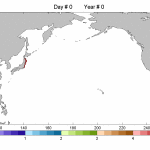
What is a marine biologist doing in Idaho? That is the question I have heard a lot lately from friends and family. The Evolution 2009 meeting is taking place right now in Moscow, Idaho. And well, deep-sea biologists are evolutionary biologists too dammit!
Thinking of Rick Macpherson I could not avoid attending Joshua S. Reece’s talk “Moray Eels: A Phylogenetic and Phlyogeographic Enigma”. Joshua presented on his dissertation work at Washington University in St. Louis that had the rather lofty goals of uncovering “Why are there so many species of moral eels?” The 200 moray eels are distributed globally, a concept nicely illustrated by Reece just showing a slide of the globe. Pick just about any part of the wet and salty earth and there will be a moray eel ready to consume your face. About 150 morays are found in the Indo-Pacific and are the focus of Reece’s work. The enigma is that moray species all do about the same thing ecologically and are morphologically very similar.
Now according to the competitive exclusion principle, two species doing the same thing in the environment, e.g. utilizing the same food source or habitat type, will compete with one another. Assuming one species is competitively superior and monopolizes the resource, it will drive the other to extinction. Now you can begin to appreciate the conundrum that is moray eels.
Reece’s approach to this question is to examine what limits and shapes species ranges of eels. Morays have extraordinary larvae, the Leptocephalus, that is an enigma in itself. The larvae contain no digestive track and no yolk but can maintain themselves in the water column from 6-24 months. It is thought that they might do this by absorbing amino acids directly through their skin. This amazing dispersal ability combined with the lack of any perceived barriers to this dispersal in the Pacific leads to the prediction that most morays would possess very broad geographic ranges. Indeed, that is exactly what Reece finds in two species using the tools from both classical biogeography and modern phylogenetics, i.e. phylobiogeography. Perhaps, the most interesting finding is that 94% of all the genetic variation found in individuals distributed throughout the Pacific in the two species can be found in a single population!
If anybody reading this is attending the meeting, come find me at the National Evolutionary Synthesis Center’s booth or at my talk Monday morning at 9:30 in the Law School Auditorium. I will be talking on the linakges of biodiversity and body size in Metazoans based on this paper.
Share the post "Moray Eels Are Everywhere and There Is One Over Your Shoulder Right Now!"





Moray caught off Cornwall